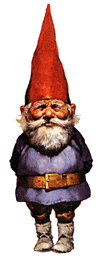

Elementals
A spirit composed purely of essential elements that haunts people or places. According to Paracelsus, there were four, each associated with one of the four elements:Gnomes (earth), Salamanders (fire), Sylphs (air), and Undines (water). Each race of beings resided in places where their element was prominent and personified their element's corresponding humor.


- Gnome
- Dwarf-like beings that live underground, guarding hoards of treasure. They are generally vegetarian and never worry. Some of them are mischievous and cause harm to humans. According to Paracelsus, they are the elementals corresponding to earth and the humor of melancholy (which actually contradicts its worriless mien, if you think about it), which causes gloominess, irritation, and depression.

- Salamander
- Saurian creature that can live in fire, often found in volcanic slopes. Alchemists used them as temperature gauges in the process of turning lead to gold: when the fire was hot enough for the process to begin, Salamanders would leap into the flames.
According to Paracelsus, Salamanders are the elementals corresponding to fire and the humor of choler (yellow bile) or blood, which was thought to bring about passion, including affection, love, and anger.
- Sylph
- According to Paracelsus, a class of soulless elementals that inhabits the air and corresponds to the humor of sanguine, which was thought to bring cheeriness within a person, as well as inspire creativity and imagination. Sylphs can be found in the thunderheads of storms and can be felt in a warm summer breeze.
- Undine
- According to Paracelsus, a female water spirit who could earn a soul by marrying a mortal and bearing his child. They were the elementals that corresponded to water and the humor of phlegm, which was thought to bring about sluggishness and lethargy.
* Note * Who is this Paracelsus?check here 
Chinese Elementals
In Chinese folklore, a similar scenario existed, and there, the four elementals were the Lung (air), Fêng Huang (fire), Ky-Lin (earth), and Pi-Hsi (water).
- Lung
- One of a group of benevolent and highly-regarded dragons of Chinese folklore that were made of the different parts of other animals: the body of a snake, scales of a carp, head of a camel, horns of a giant stag, the eyes of a hare, ears like a bull, a neck like an iguana, belly of a frog, paws like a tigers, and claws like an eagle. The Lung had five toes and held pearls wherein they drew their powers from, and they represented the elemental force of air.
- Fêng-Huang o Chinese Phoenix
- The sun's messenger and herald of peace that could always be seen flying high in the sky when a new Emperor ascended the thrown. Fêng is male and Huang is female; together they represent everlasting love, and the elemental force of fire. They have the heads and combs of pheasants, the feathers of a peacock, three legs, beautiful plumage, and sweet songs.
- Ky-Lin o Ki-Lin o Qi-Lin
- Chinese creature that was the most perfect of all land animals, with the head of a dragon bearing a single horn, the mane of a lion, the body of a stag, and the tail of an ox. Ky is the male and Lin is the female, embodying the balance of the Chinese Ying-yang. It only appeared when a great Emperor was at power, or to herald the birth of a great person. The Ky-Lin was the symbol of benevolence, good will, and fertility, and it was the elemental corresponding to earth.
- Pi-hsi
- Tortoise of Chinese legends that presided over rivers and corresponded to the elemental force of water.


|

|


|